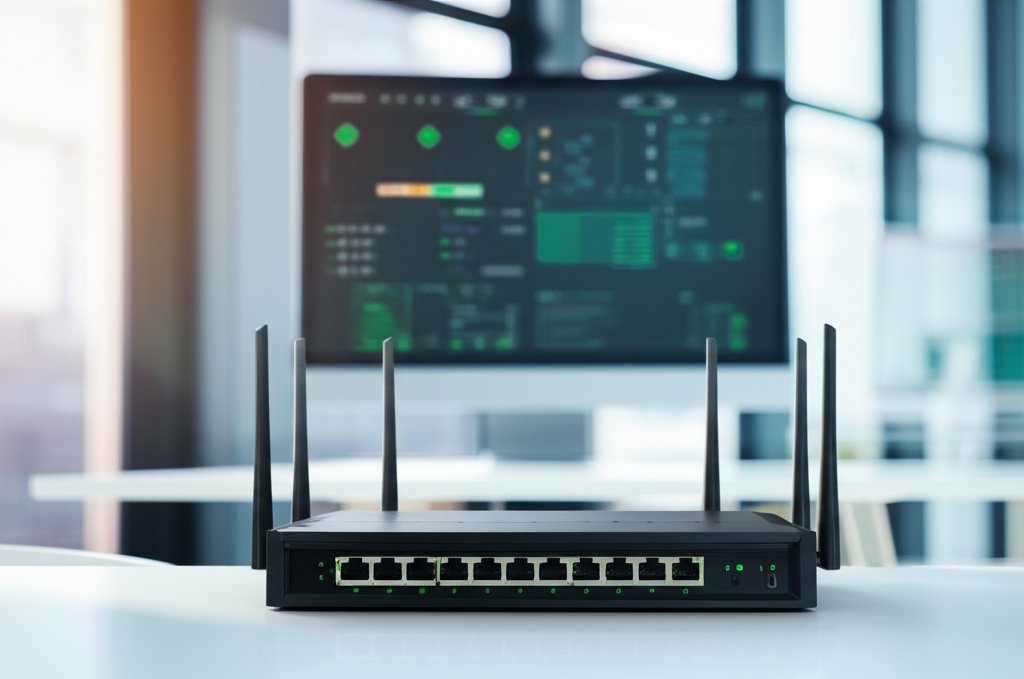The way we work has fundamentally transformed. What began as a temporary response has solidified into a new reality: remote and hybrid work models are now standard. This flexibility brings immense advantages, but it also ushers in a complex landscape of cybersecurity challenges. Your home network lacks the robust defenses of a corporate office, and personal devices can inadvertently become weak links, opening doors for attackers. In fact, a recent report by IBM highlighted that the average cost of a data breach for companies with a high percentage of remote work was significantly higher, emphasizing the increased risk. So, how do we effectively safeguard our sensitive data when the traditional ‘castle-and-moat’ security perimeter of an office is no longer relevant?
The answer lies in Zero Trust security. This modern, powerful framework moves beyond simply trusting who’s ‘inside’ and who’s ‘outside’ your network. For small businesses, remote employees, and even individuals navigating hybrid work, understanding and implementing Zero Trust principles isn’t just for tech giants; it’s a vital and accessible approach to enhance your digital defenses. We’re here to show you how to apply these cybersecurity tips for hybrid work using Zero Trust.
What is Zero Trust, Simply Put?
Imagine you’re hosting a party, and every guest, even your closest friends and family, must present their ID and clearly state their purpose before entering each specific room. Furthermore, they might be re-verified if they try to access another room or a sensitive area. That’s essentially Zero Trust. The core concept is simple: never trust, always verify. No user, no device, and no application is implicitly trusted, regardless of their location or prior access. Every single access request is continuously authenticated, authorized, and validated.
Traditional security models often assume that once you’ve gained initial access to the network, you’re trustworthy. This ‘castle-and-moat’ approach worked well when everyone was physically within the “castle” walls. However, with the rise of remote and hybrid work, your team members access resources from potentially insecure home Wi-Fi networks, public hotspots, and personal devices. The ‘moat’ becomes irrelevant, and the ‘castle’ walls are now riddled with holes. Zero Trust explicitly addresses this shift, offering a robust and adaptable defense for our distributed workforces. It’s a fundamental change in how we approach digital trust.
Why Zero Trust is a Game-Changer for Remote & Hybrid Work Security
Why should you prioritize Zero Trust for your remote setup or small business? Because it directly confronts the most pressing security challenges introduced by the modern work environment:
- Mitigates an Expanded Attack Surface: Every home network, personal device, and cloud service connected to your work resources represents a potential entry point for cyber threats. Zero Trust treats all these endpoints as untrusted until proven otherwise, providing crucial Zero Trust principles for remote employees.
- Minimizes Unauthorized Access & Data Breaches: By strictly verifying every access request, Zero Trust significantly reduces the risk of an attacker gaining unauthorized access to your sensitive data, even if they manage to compromise a single account or device. This is key for secure remote work solutions.
- Ensures Consistent Security: Zero Trust ensures that stringent security policies are applied uniformly, whether an employee is in the office, working from home, or traveling. This consistency is crucial for maintaining control over a geographically dispersed workforce.
- Streamlines Compliance Efforts: For small businesses, navigating complex data protection regulations can be daunting. Zero Trust principles often align with and actively help you achieve compliance with various industry standards by significantly enhancing your overall security posture. You can master Zero Trust to future-proof your remote work security.
It’s about adopting a proactive mindset, assuming compromise is possible, rather than passively waiting for it to happen. Zero Trust security builds a new, resilient trust baseline for the digital age, essential for hybrid work cybersecurity.
10 Essential Zero Trust Security Principles You Can Implement Today
Let’s dive into the core Zero Trust principles. Remember, these aren’t just for large corporations; you can effectively apply them to your personal remote work setup and small business operations. Our goal is to empower you to take control of your digital security without needing to be a cybersecurity expert.
1. Verify Explicitly (The “Never Trust, Always Verify” Mantra)
This is the fundamental bedrock of Zero Trust. It means that every access request from every user and every device is thoroughly authenticated and authorized before access is granted. There are no automatic passes based on location; every interaction is treated as if it’s coming from an untrusted network environment.
What it means for you/your small business: You can’t just assume a user or device is legitimate because it looks familiar. Every single attempt to access data or an application must be verified. This constant vigilance helps prevent attackers from moving freely even if they manage to compromise a single account. This is a core part of `never trust always verify principles`.
Actionable Tip: Never assume an email, link, or login request is safe just because it appears to be from a known source. Always double-check by hovering over links, verifying sender addresses, and asking yourself: “Does this look right?” For businesses, enforce strong, unique login policies for all services and accounts and leverage contextual information (device health, location) for access decisions.
2. Use Least Privilege Access
Least privilege means granting users only the absolute minimum access to resources they need to perform their specific tasks, and only for the shortest possible duration. It’s like giving someone a key only to the room they absolutely need to enter, not a master key to the entire building.
What it means for you/your small business: If an employee only needs to view customer service tickets, they should not have access to your company’s sensitive financial records. This principle minimizes the potential damage an attacker can inflict if an account is compromised, as their access will be severely limited. This is crucial for `least privilege access for hybrid work` environments.
Actionable Tip: Regularly review who has access to sensitive files, applications, and systems. If an employee no longer requires access to a particular resource for their job function, revoke it immediately. For individuals, be mindful of app permissions on your phone and computer; only grant what is truly necessary for functionality.
3. Assume Breach (Prepare for the Worst)
This principle dictates that you should operate under the assumption that a breach will happen, or has already happened. It’s not about being pessimistic; it’s about being realistic and building resilient systems that can quickly contain and mitigate attacks, rather than solely focusing on prevention.
What it means for you/your small business: Instead of asking “How do we prevent a breach?”, ask “What do we do when a breach occurs?” This mindset shifts your focus from just prevention to also detection, containment, and recovery. It emphasizes layered security defenses and robust `incident response planning for remote employees`.
Actionable Tip: Have a clear, simple plan for what to do if an account or device is compromised. Know who to contact, how to change passwords quickly across critical services, and how to isolate a potentially infected device. Back up all important data regularly to an encrypted, offsite location so you can recover quickly from a data loss event.
4. Implement Multi-Factor Authentication (MFA)
Multi-Factor Authentication (MFA), often referred to as two-factor authentication (2FA), requires more than one method to verify your identity. This typically combines something you know (like a password) with something you have (like a code from your phone) or something you are (like a fingerprint or facial scan).
What it means for you/your small business: MFA is one of the single most effective ways to prevent unauthorized access, even if your password is stolen. It adds a critical, near-impenetrable layer of defense, making it significantly harder for cybercriminals to break into your accounts. It’s a cornerstone of `MFA for remote teams`.
Actionable Tip: Enable MFA on all your online accounts that offer it – especially for work-related services, email, banking, and social media. Using an authenticator app (like Google Authenticator, Authy, or Microsoft Authenticator) is generally more secure and convenient than relying on SMS codes. For a deeper dive into advanced authentication, consider exploring the security of passwordless authentication.
5. Micro-segmentation (Divide and Conquer)
Micro-segmentation involves dividing your network into small, isolated security zones, each with its own granular security controls. This way, if one part of your network or a specific application is compromised, the damage is contained within that small segment and doesn’t spread across your entire environment.
What it means for you/your small business: It’s like having separate, locked rooms within your building, rather than just one large open space. For small businesses, this can mean logically separating sensitive financial data from general employee files or isolating a vulnerable legacy application. For individuals, it helps contain threats on your home network.
Actionable Tip: For home users, consider setting up a guest Wi-Fi network for smart home devices and less critical personal devices, keeping your work devices on your primary, more secure network. Many modern routers support this simple form of micro-segmentation. Businesses should explore network segmentation tools or cloud service capabilities.
6. Continuous Monitoring & Validation
Zero Trust is not a one-time setup; it demands continuous monitoring and re-validation of users, devices, and connections. Security posture is dynamic, not static. Systems constantly check for suspicious activity, policy violations, and changes in behavior, flagging anything out of the ordinary.
What it means for you/your small business: This means always keeping an eye on who is accessing what, from where, and when. If a user normally logs in from New York but suddenly appears to be logging in from an unknown country, the system should flag it and re-verify their identity or block access. This is essential for cybersecurity tips for hybrid work using Zero Trust.
Actionable Tip: Pay attention to login alerts from your email and other critical services. Use security software (antivirus/antimalware) that offers real-time threat detection. If your business uses cloud services like Microsoft 365 or Google Workspace, regularly review their activity and access logs for unusual patterns or suspicious events.
7. Secure All Endpoints (Devices Matter)
Every device that accesses company resources – laptops, phones, tablets, even smart devices – is an “endpoint.” Under Zero Trust, all these endpoints must be secure, regularly updated, and compliant with security policies before they are allowed to connect or maintain access.
What it means for you/your small business: A weak link in any device can expose your entire operation. Ensuring all devices are patched, protected, and properly configured closes common entry points for attackers. To truly fortify your remote work security, securing all endpoints, especially personal devices (BYOD), is crucial for secure remote work solutions.
Actionable Tip: Keep operating systems (Windows, macOS, iOS, Android) and all software applications updated to their latest versions. Use reputable antivirus/antimalware software on all your devices. Encrypt your device storage (e.g., BitLocker for Windows, FileVault for macOS) so data is unreadable if the device is lost or stolen.
8. Prioritize Data Protection
While devices and networks are important, the ultimate goal of Zero Trust is to protect your sensitive data. Security efforts should be focused on the data itself, regardless of where it resides – whether it’s on a local server, in the cloud, or on an employee’s laptop.
What it means for you/your small business: You need to know what your most critical data is, where it’s stored, and who has access to it. Classifying your data (e.g., public, internal, confidential, sensitive) helps you apply the right level of protection to each category, ensuring Zero Trust security for small business data.
Actionable Tip: Use strong encryption for sensitive files and communications. Understand where your data is stored (cloud services often have built-in encryption, ensure it’s enabled). Implement Data Loss Prevention (DLP) tools if your budget allows, which can prevent sensitive information from leaving your control.
9. Leverage Zero Trust Network Access (ZTNA) Over Traditional VPNs
Zero Trust Network Access (ZTNA) is a technology that replaces or significantly enhances traditional Virtual Private Networks (VPNs). To truly master ZTNA for enhanced security, understand that instead of granting broad network access, ZTNA provides highly granular, “just-in-time” access only to specific applications or services, rather than the entire network.
What it means for you/your small business: Traditional VPNs connect a remote user to the entire corporate network, essentially extending the ‘castle’ to their home. If an attacker compromises a VPN-connected device, they can potentially access anything on the network. ZTNA only connects users to the specific applications they need, drastically reducing the attack surface. This allows for more secure Zero-Trust access for remote workers and demonstrates the benefits of `ZTNA vs VPN for remote access`.
Actionable Tip: If your business heavily relies on a traditional VPN, research ZTNA alternatives or solutions that integrate ZTNA principles. Many cloud-based security providers offer ZTNA as a service. Understanding this distinction helps in evaluating future security solutions for your small business.
10. Educate and Train Employees Regularly
Humans are often the weakest link in any security chain. Ongoing security awareness training for all employees (and yourself!) is not just a good idea; it’s an absolutely crucial component of a successful Zero Trust strategy and one of the most important `cybersecurity tips for hybrid work`.
What it means for you/your small business: Even the most advanced security systems can be bypassed by a cleverly crafted phishing email or social engineering attack. Empowering your team with knowledge makes them your first line of defense. A well-informed employee is a powerful asset in the fight against evolving cyber threats.
Actionable Tip: Stay informed about the latest phishing scams and common cyber threats. Learn to recognize suspicious emails, texts, and phone calls. Encourage open communication within your team about potential security risks without fear of reprisal. For businesses, conduct regular (even quarterly) short, engaging training sessions or share security bulletins.
Implementing Zero Trust for Small Businesses: Getting Started
Adopting a Zero Trust framework might sound overwhelming, but you absolutely don’t have to overhaul everything at once. Here’s how small businesses can effectively start implementing Zero Trust security for small business:
- Start Small, Aim Big: Focus on foundational principles first. Implementing MFA on all accounts and enforcing least privilege access are excellent, high-impact starting points that yield significant security benefits for relatively low effort.
- Inventory Your Digital Assets: You can’t protect what you don’t know you have. Make a comprehensive list of all your critical data, applications, and devices. Understand precisely where your sensitive information lives and who accesses it.
- Leverage Existing Tools: Many cloud services you already use, like Microsoft 365, Google Workspace, and popular CRM platforms, have built-in Zero Trust features (e.g., conditional access policies, MFA, granular permissions). Explore and enable these features to maximize your current investments.
- Consider Professional Guidance: As your business grows, or if you feel out of your depth, don’t hesitate to engage an IT or cybersecurity provider. They can help you assess your current posture, recommend scalable Zero Trust solutions, and assist with implementation, ensuring your `Zero Trust principles for remote employees` are well-applied.
Conclusion
The permanent shift to remote and hybrid work has fundamentally altered the cybersecurity landscape, rendering traditional ‘castle-and-moat’ defenses less effective. Zero Trust security, with its unwavering “never trust, always verify” mantra, offers the robust, adaptable protection our distributed workforces desperately need. It’s not just a buzzword; the truth about Zero Trust is that it’s a critical mindset and a framework of practical principles that empower you to take control of your data and devices.
By understanding and implementing these 10 essential Zero Trust principles – from explicit verification and least privilege to continuous monitoring and vital employee education – you can significantly fortify your remote and hybrid work security posture. Don’t wait for a breach to happen and incur significant costs. Be proactive, embrace the Zero Trust philosophy, and build a more resilient digital environment for yourself and your small business. Protect your digital life! Start with a reputable password manager and enable multi-factor authentication on your critical accounts today.






